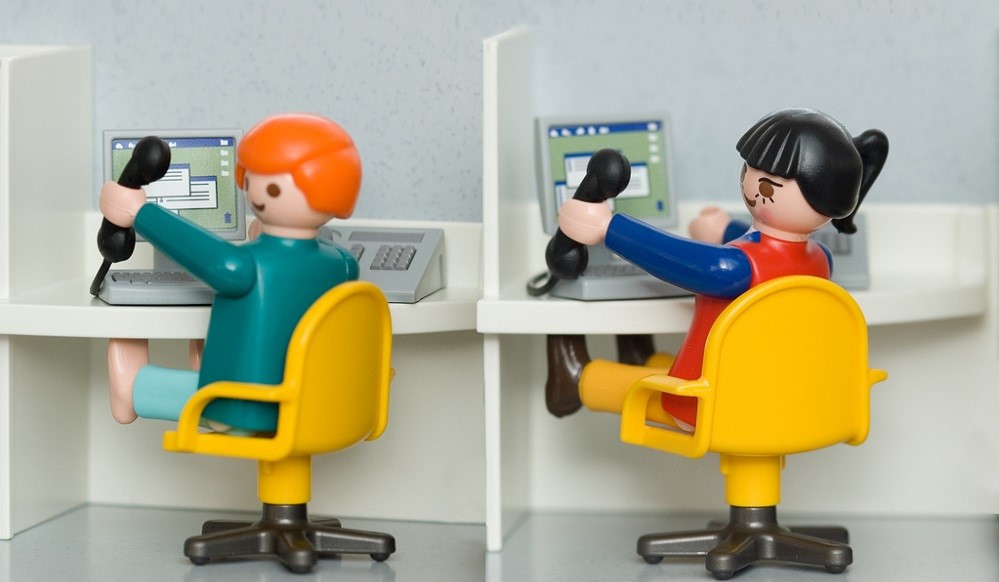Directional sound: technology that can replace headphones — how it works
Next year, at CES 2019, start-up Noveto plans to present a sound-oriented audio system designed for the mainstream market. This speaker, the sound from which he hears only one person in the room, as if he was wearing headphones.
We tell how it works and where such technologies are already used.

Photo by Karim D. Ghantous / CC
Such systems differ from conventional speakers in that they form a narrow audio stream that is heard only in front of it. The first dynamics of the directional sound appeared in the late 80s.
The design was quite primitive. They represented the usual speakers, hung from the ceiling, which were surrounded by a plastic dome. The sound was reflected from the inner surface of the dome and was heard only by a person directly under the device.
In the 90s, another technology appeared that uses ultrasound. In this case, the column using piezoelectric transducersemits a sound whose frequency is outside the range of a person’s hearing. But as sound waves propagate through the air, audible frequencies appear (due to non-linear effects).
These systems have a serious drawback. They are designed for the fact that the listener is in one place - often the speakers are placed on the ceiling, and the sound is concentrated at the point below them.
Solved this problem engineers Israeli startup Noveto. Their directional sound system is able to transmit sound to the listener , regardless of its location in the room.
The loudspeaker has 3D sensors that track the position of the user's head. After that, the system itself calculates in which direction and at what angle it is necessary to send sound waves (in this case, ultrasound is also used). As a result, “virtual headphones” are formed on the user's ears - small areas in which music is heard.
Sensors react to the movements of the listener and move the sound stream if the person turns his head or sits down at another place. The system is capablerecognize several people sitting next to each other and each send a personal audio stream of different volume.
A demonstration of the technology can be seen in this video from CNBC:
Now the Noveto system is at the development stage, so it has certain drawbacks. For example, if you turn to the speaker with one ear, then the sound will only flow into it (obviously, the system simply "does not see" the second ear). However, according to company representatives, this can be corrected by placing an additional audio system on the ceiling.
Another point that is also being worked on is sound quality. As journalists write from Business Insider, Noveto speakers still reproduce audio with distortion. Plus, such systems, due to implementation features, poorly lose low frequencies. The CEO of a startup says that over time, the sound quality of the system will be significantly improved.
Nowadays, directional sound systems are rarely found in everyday life. They are mainly used in museums or exhibitions. Visitors can listen to lectures by electronic guides and not disturb others. Sometimes such systems can be found in stores near the shelves with the advertised product. Such technologies are also used in banks. For example, in some branches of Sberbank, they installed terminals for video consultations with directional sound speakers.
It is expected that with the advent of compact systems similar to Noveto devices, directional sound will become more familiar technology. And the most promising areas of its application are audio systems for offices and cars.
In the office, directional sound systems can be equipped with video conferencing rooms or employees' workplaces, which are forced to spend most of the day in headphones. These are dispatchers or call center operators.

Photo Bryce Johnson / CC
In cars, the directional sound can be used by the driver to answer the call, or passengers who want to listen to music and not distract the person behind the wheel. In particular, Noveto has already made a deal with the company SEAT, which will test the new audio system in their cars.
Directed sound interested and other car companies, in addition to SEAT. Hyundai and KIA are working on the Separated Sound Zone system. Each seat in the car will be equipped with a separate directional column, so all passengers will be able to listen to different music or podcasts and not interfere with each other.
Similar audio system plans to introduce and Renault. The company has invested in a startup Akoustic Arts, which is developing "personal" speakers.
At CES 2018, along with the Noveto system, was presentedSamsung's compact S-Ray directional speaker. This device fits in the palm of your hand and can be connected to a smartphone. The column was created in the Samsung C-Lab creative laboratory, and so far only the first prototype of the device is ready.
Despite its potential and the statements of Noveto's CEO, directional sound technology will not replace headphones for a long time. If only because all these projects are in the early stages of their development. However, technology has potential, and perhaps in the future it will be able to express itself in the most diverse areas of our life.
PS More about audio technology sound and music - in our Telegram-channel :
 Space sound Haken Continuum
Space sound Haken Continuum
 Our rating headphone
Our rating headphone
 guide for the beginner: it is important to know about the ear cushions headphone
guide for the beginner: it is important to know about the ear cushions headphone
 Our buyer's guide: Bookshelf speakers vs Floor
Our buyer's guide: Bookshelf speakers vs Floor
 Music for productive work
Music for productive work
We tell how it works and where such technologies are already used.

Photo by Karim D. Ghantous / CC
What is a directional sound system
Such systems differ from conventional speakers in that they form a narrow audio stream that is heard only in front of it. The first dynamics of the directional sound appeared in the late 80s.
The design was quite primitive. They represented the usual speakers, hung from the ceiling, which were surrounded by a plastic dome. The sound was reflected from the inner surface of the dome and was heard only by a person directly under the device.
In the 90s, another technology appeared that uses ultrasound. In this case, the column using piezoelectric transducersemits a sound whose frequency is outside the range of a person’s hearing. But as sound waves propagate through the air, audible frequencies appear (due to non-linear effects).
These systems have a serious drawback. They are designed for the fact that the listener is in one place - often the speakers are placed on the ceiling, and the sound is concentrated at the point below them.
How to solve this problem
Solved this problem engineers Israeli startup Noveto. Their directional sound system is able to transmit sound to the listener , regardless of its location in the room.
The loudspeaker has 3D sensors that track the position of the user's head. After that, the system itself calculates in which direction and at what angle it is necessary to send sound waves (in this case, ultrasound is also used). As a result, “virtual headphones” are formed on the user's ears - small areas in which music is heard.
Sensors react to the movements of the listener and move the sound stream if the person turns his head or sits down at another place. The system is capablerecognize several people sitting next to each other and each send a personal audio stream of different volume.
A demonstration of the technology can be seen in this video from CNBC:
Now the Noveto system is at the development stage, so it has certain drawbacks. For example, if you turn to the speaker with one ear, then the sound will only flow into it (obviously, the system simply "does not see" the second ear). However, according to company representatives, this can be corrected by placing an additional audio system on the ceiling.
Another point that is also being worked on is sound quality. As journalists write from Business Insider, Noveto speakers still reproduce audio with distortion. Plus, such systems, due to implementation features, poorly lose low frequencies. The CEO of a startup says that over time, the sound quality of the system will be significantly improved.
Where technology will be applied
Nowadays, directional sound systems are rarely found in everyday life. They are mainly used in museums or exhibitions. Visitors can listen to lectures by electronic guides and not disturb others. Sometimes such systems can be found in stores near the shelves with the advertised product. Such technologies are also used in banks. For example, in some branches of Sberbank, they installed terminals for video consultations with directional sound speakers.
It is expected that with the advent of compact systems similar to Noveto devices, directional sound will become more familiar technology. And the most promising areas of its application are audio systems for offices and cars.
In the office, directional sound systems can be equipped with video conferencing rooms or employees' workplaces, which are forced to spend most of the day in headphones. These are dispatchers or call center operators.

Photo Bryce Johnson / CC
In cars, the directional sound can be used by the driver to answer the call, or passengers who want to listen to music and not distract the person behind the wheel. In particular, Noveto has already made a deal with the company SEAT, which will test the new audio system in their cars.
Who else develops such systems?
Directed sound interested and other car companies, in addition to SEAT. Hyundai and KIA are working on the Separated Sound Zone system. Each seat in the car will be equipped with a separate directional column, so all passengers will be able to listen to different music or podcasts and not interfere with each other.
Similar audio system plans to introduce and Renault. The company has invested in a startup Akoustic Arts, which is developing "personal" speakers.
At CES 2018, along with the Noveto system, was presentedSamsung's compact S-Ray directional speaker. This device fits in the palm of your hand and can be connected to a smartphone. The column was created in the Samsung C-Lab creative laboratory, and so far only the first prototype of the device is ready.
Despite its potential and the statements of Noveto's CEO, directional sound technology will not replace headphones for a long time. If only because all these projects are in the early stages of their development. However, technology has potential, and perhaps in the future it will be able to express itself in the most diverse areas of our life.
PS More about audio technology sound and music - in our Telegram-channel :
 Space sound Haken Continuum
Space sound Haken Continuum  Our rating headphone
Our rating headphone  guide for the beginner: it is important to know about the ear cushions headphone
guide for the beginner: it is important to know about the ear cushions headphone  Our buyer's guide: Bookshelf speakers vs Floor
Our buyer's guide: Bookshelf speakers vs Floor  Music for productive work
Music for productive work